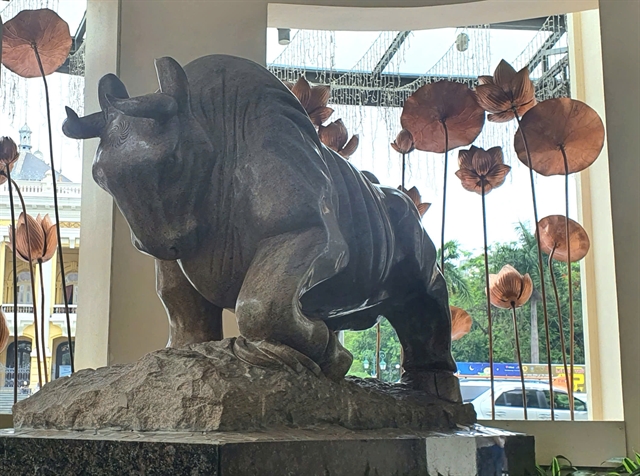.jpg)
.jpg)
Improved transport infrastructure has helped to increase real estate activity in HCM City and neighbouring southern provinces, including Long An, Đồng Nai and Bình Dương.
 |
| My Thuận bridge in connects Tiền Giang and Vĩnh Long provinces. Improved transport infrastructure has helped to increase real estate activity in HCM City and neighbouring southern provinces, including Long An, Đồng Nai and Bình Dương. — Photo tuoitre.vn |
HCM CITY — Improved transport infrastructure has helped to increase real estate activity in HCM City and neighbouring southern provinces, including Long An, Đồng Nai and Bình Dương.
Transport development has been one of the strong points of the property market this year, according to CBRE Việt Nam.
In the past few years, several road projects have opened, including the Phạm Văn Đồng Highway linking Tân Sơn Nhất Airport with National Highway No 1A, running through Bình Dương Province’s Dĩ An District to Biên Hoà City in Đồng Nai Province.
From 2000 to 2010, when the eight-lane Phạm Văn Đồng Highway had yet to open, no real estate projects existed along the route.
But after 2010, a number of big projects, such as Đất Xanh, Him Lam Land and Thủ Đức House, were built along the new highway in HCM City and Bình Dương Province.
Previously, real estate projects were built before infrastructure development occurred, but now transport infrastructure is a pre-condition for new property projects.
Before 2007, few property projects were seen along Nguyễn Văn Linh Highway, which connects districts 2, 7, 8 and Bình Chánh with Long An Province.
However, the new 10km highway has triggered a construction boom of apartment buildings along the road.
The 10-km Võ Văn Kiệt Avenue which links the city’s District 1 with National Highway No 1A to Long An Province and the Mekong Delta has paved the way for a number of property projects, including Novaland, 577, Nam Long and Vietcomreal.
The new Võ Văn Kiệt Avenue has also spurred development of apartment buildings near the road after a couple of years of stagnancy.
The newly upgraded and enlarged Mai Chí Thọ Street and Hà Nội Highway, which connect HCM City with Đồng Nai Province, have also jump-started a construction boom of apartment building projects in the area.
Figures from the HCM City Department of Transport show that over 50 property projects, with more than a total of 30,000 apartments, have been built along these two roads.
In addition, construction of the Metro Line No 1 in HCM City has helped promote the property market, despite financial challenges faced by the metro project.
Since 2007, when construction of the Metro Line No 1 began, at least 20 real estate projects with a total of 20,000 apartments have been built along the route.
Bùi Xuân Cường, director of the city’s Department of Transport, said the city would develop more roads and bridges in suburban areas as more residents move from the inner city to suburbs.
“It’s easy to see the rapid growth of property in areas where transport infrastructure has developed. This is a sign of equal growth of the city’s main property areas,” Cường said.
Nguyễn Thành Phong, chairman of the city People’s Committee, said the city had given priority to investment in transport projects, and had given red-carpet invitations to potential investors.
The city has called for investments in 100 projects under the PPP (Public-Private-Partnership) form, mainly investment in transport infrastructure, which also benefits neighboring southern provinces.
Sử Ngọc Khương from Savills Việt Nam said HCM City’s policy on transport projects has been on the right track, with shifts from inner to suburban districts.
More property projects when the Cát Lái Bridge opened, linking the city with Đồng Nai Province’s Nhơn Trạch District, and after the HCM City–Long Thành–Dầu Giây–Phan Thiết Expressway was built in 2009.
When the property market in Bình Dương Province faced stagnant growth, the property market in Dĩ An, a district bordering HCM City, showed signs of revival, with apartments in 10 property projects on sale since 2013.
Similarly, with the extension of Lê Trọng Tấn and Trường Chinh streets, and National Highway No 22 linking western areas of HCM City with Đức Hoà District in Long An Province, the property market of Đức Hoà District expanded, with nearly 20 apartment building projects on sale since 2010.
The developers of these property projects told customers that it would take only a half hour to travel by motorbike from HCM City’s inner district to the apartments in Đức Hoà District, according to Khương.
“The region’s transport infrastructure development has paved the way for the sustainable development of the real estate market in HCM City and neighbouring provinces,” Khương said. VNS
.jpg)



